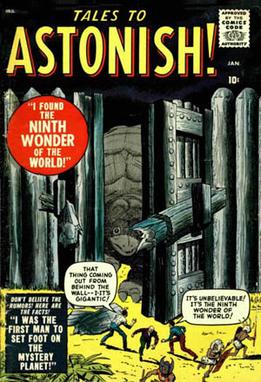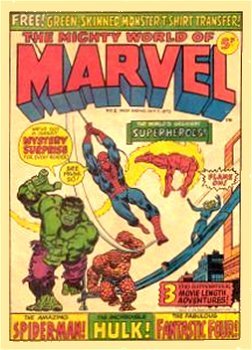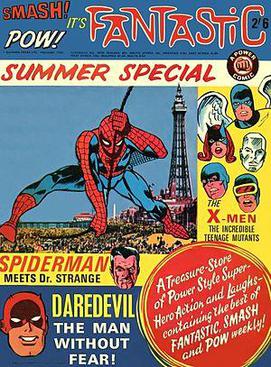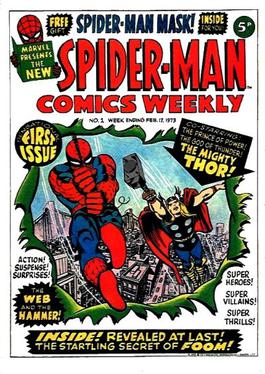Effect of television on the comics industry
The history of Power Comics is really a history of the managed decline of the British comics industry in general during the 1960s, in the face of falling sales resulting from the growing power of television. In the course of that decade, the British television industry introduced a new channel (BBC2 in 1964), cheaper television sets (in consequence of the transistor revolution), hire-purchase (broadening the market so that anyone could afford a TV), and — dealing a near death-blow to mass-market comics — launched British television into colour in Christmas 1969.
With the advent in Britain of commercial television, in 1955 – displacing the staid, old-fashioned children's television offered by the BBC up to that point – the ever-increasing competition from TV began a continuous (and accelerating) decline in comics circulation. Throughout the 1960s, in consequence, the circulation wars fought in the comics publishing industry were fought out against a backdrop of ever-declining circulation figures.
In a limited market such as the UK, Odhams took a big risk to launch five titles. It has been suggested [8] that it was common practice for a publisher to quickly clone a successful title, in order to forestall its competitors from doing so, but it does not seem to be the case here. Smash's only distinctive feature was its American superhero strips, so Fantastic and Terrific (which most of the time contained only Marvel superhero strips) might loosely be described as clones of Smash!, even though they lacked any humour strips, but IPC had an exclusive licence from Marvel Comics to reprint Marvel's strips in the UK, which precluded anyone else from doing so.
Burden cost of Marvel Comics license
These repeated falls in the value of the pound against the U.S. dollar significantly increased the cost of publishing the American strips, which had to be paid for in dollars, and raised the daunting spectre of further increases if the pound fell in value yet again. Increasing the cover price of the Power Comics titles to compensate was impossible because of stiff competition (with sales on a sharp downward spiral, as circulation fell victim to the ever-increasing popularity of television); so the fall in the value of Sterling made the American strips unaffordable.
The toughness of the competition is apparent from examining other contemporary titles. The first issue Fantastic , published in February 1967, cost 9d for 40 pages (due to its very high content of American superhero strips), a cover price which forced Fantastic to close within 18 months. Terrific , having the same high content of American material, also had a high cover price of 9d, and closed even quicker.
In contrast, the comics The Dandy and The Beano published by rival DC Thomson, sold at a cover price of 3d. Fantastic! and Terrific! cost three times as much, which (even with double the number of pages compared to many DC Thomson titles) proved unsustainable. This is not surprising, given that Wham! and Pow! each peaked at a cover price of 7d, and even that proved unsustainable.
Smash! had launched in February 1966 with a cover price of 7d for 24 pages. By March 1969, although its cover price had not changed, circumstances had conspired to increase its page count, such that each issue now contained 36 pages. In fact the page-count jumped overnight from 24 to 36 pages (a fifty per cent increase), with a consequent sharp rise in production costs, and so a marked decline in profit-per-copy.
The tipping point was Smash! issue #144, in which Smash!, Pow!, and Fantastic were merged into a single title. The recently created Smash and Pow lost its Daredevil and Spider-Man strips, which together had comprised a full third of each 24-page issue, but now had to accommodate both Thor and Fantastic Four from the discontinued titles, plus a whole slew of new British adventure strips (which were being added in preparation for the comic's impending transition to solely-British content).
All this could not be achieved within the standard Smash! format of 24 pages. IPC "bit the bullet" and increased the page count, at a single bound, by fifty per cent – a necessity if they were to achieve their intention of reproducing with Smash! the successful formula which was buoying-up sales of their most popular titles, Lion and Valiant, both of which were 36-pagers (in effect, to produce another clone of them: an identical mix of adventure and humour, with an identical page count, at an identical price).
One fundamental difficulty for the Power Comics line, however, was always the stark economic truth that a kid could buy both The Dandy and The Beano, at 3d each, and still have change left over, for what it cost to buy Smash!, Wham! or Pow! at 7d each. The DC Thomson titles only had 16 pages, and this more than anything drove up the page count in Smash!, from its original 24 to 36 pages, and eventually to 40 pages in 1970 (i.e. it might be more than double the price of a DC Thomson title but it was also more than double the size). [11] The difficulty was that the much lower price of The Dandy and The Beano gave those titles a significant advantage, since a kid could choose to buy only one of them, at 3d – a winning competitive advantage which, as of 1966, would keep both of the DC Thomson titles afloat for more than 30 years to come.
The highly competitive nature of the UK's publishing industry meant margins were thin: a minimum number of sales each week were needed to reach break-even point, and the lower the cover price, the greater was the number of sales needed to reach that point; but the higher the cover price, the fewer were the number of sales that could actually be achieved.
The juvenile readers (or their parents) might be able to afford two or three comics a week, but by publishing five Power Comics titles, IPC were pricing themselves out of the market. The situation in Britain was not like that in America, where, with comics published just once a month, a child might afford five titles; in Britain, comics were published weekly.
Under those conditions the Power Comics were effectively competing with each other – a factor IPC were certainly aware of, as the letters pages in Smash! in 1968 actually carried readers' complaints that they couldn't afford all five Power titles. The five together cost an astonishing three shillings and threepence a week (39d), to buy them all, far beyond the reach of the average child's weekly pocket money. [12]
The Power Comics titles were also competing with IPC's other titles, including Lion , Valiant , and Buster , potentially dragging the group's entire line into bankruptcy. Rationalisation, by closing some of the titles, would produce an overall benefit, as it would dramatically cut IPC's production costs. Although it would mean fewer titles, as IPC's comics were actually competing against each other it ought to result in better sales for the survivors. In theory, there would be no overall loss of sales or revenue, provided readers switched from the closing titles to surviving IPC ones (rather than to rival DC Thomson ones).
Distribution of Marvel Comics in the UK
Another factor Odhams had not anticipated was the distribution of American comic books within the UK. Although this had always been a consideration, the volume of such comics arriving in Britain had traditionally been small, and their distribution haphazard. In 1968, distribution and quantity suddenly underwent a marked improvement: in America, Marvel Comics' owner, Martin Goodman, pulled off a business coup that overnight freed Marvel from a restrictive distribution agreement, which for a decade had limited it to publishing only 8 titles a month: Marvel was suddenly quadrupling its monthly output, and dozens of new titles were flooding into Britain. [13] Odhams' black-and-white Marvel reprints in their Power Comics range suddenly faced much more extensive competition from four-colour Marvel originals, and this began to harm sales. [14]
In the turbulent economic conditions, any part of IPC's business that was loss-making had no future. Standard industry practice was to close a comic or magazine if its revenues dipped towards the break-even point; publishers did not wait for a title to actually incur losses. [8] Hence, merely to anticipate losses on the other four titles (Pow!, Wham!, Fantastic and Terrific) was enough to doom them. The closures represented a major cost-cutting exercise, reducing the ongoing production costs on the Power Comics line by four-fifths.
As for actual losses incurred due to the sudden and unexpected nature of the problem, and the inability to quickly terminate the long-term licensing contracts with the Americans, Smash! as sole survivor couldn't hope to generate enough income on its own to meet these. In fact, it didn't need to. The fortunate circumstance that the Power Comics were all published by Odhams Press Ltd, a subsidiary company with limited liability, meant that it was possible to ring-fence all debts on the Odhams publications within that one company, thus preventing any losses affecting the rest of the IPC Group (since IPC's other titles were all published by other IPC subsidiaries). Accordingly, with effect from 1 January 1969 Smash! was transferred to IPC Magazines Ltd, a new IPC subsidiary formed during 1968, [15] leaving Odhams with no continuing titles, and Smash! started again from scratch. [lower-alpha 3]

















